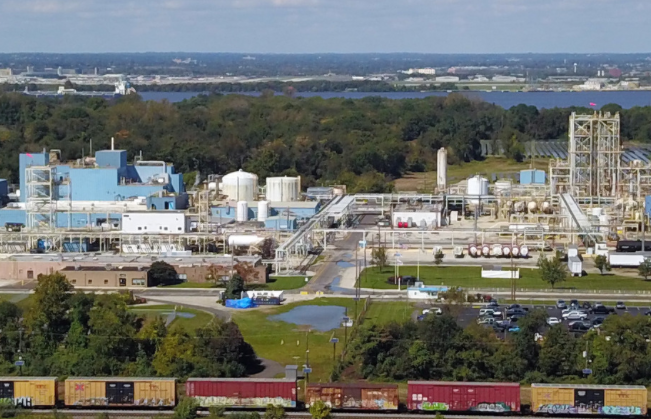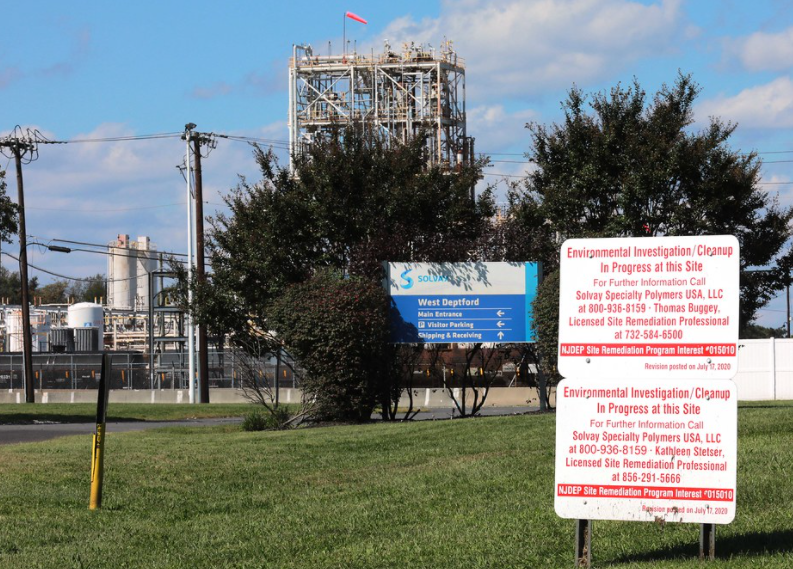Is EPA putting interests of chemical companies ahead of your health? These experts think so
Scientists first discovered the tasteless, odorless chemicals along a stretch of southern New Jersey in 2020. Combinations of carbon and fluorine molecules littered the soil and water, where they were absorbed by fish and, quite possibly, the people who live there.
The compounds are part of a family of thousands of per- and polyfluoroalkyl substances, or PFAS, used for decades in consumer products like Teflon cookware, rain gear, and food packaging. The more scientists research PFAS, the more concern emerges about their potential health effects.
Studies of the South Jersey PFAS showed that when rats were dosed with even extremely small amounts, they suffered liver and neurological damage, along with drops in red blood cell counts. The results led the state to issue in January an emergency safety limit for the chemicals in water and soil. New Jersey is now on track to become the first state in the country to regulate them.
On the surface, the chain of events appears to show a system functioning to protect people from harmful substances. Scientists discovered the chemicals, studied their toxicity, and moved to protect the public in a matter of years.
But in reality, experts say, the system failed.

Records show a local plastics plant had been polluting the air and water with the chemicals for a quarter century. Documents indicate the U.S. Environmental Protection Agency knew in advance of the chemicals’ danger but took no action, even after being criticized for PFAS crises in other states.
Two EPA employees described to USA TODAY an agency culture in which business interests are prioritized over public health, and where information that could be useful to scientists studying the effects of new chemicals is concealed from the public.
What are PFAS?: A guide to understanding chemicals behind nonstick pans, cancer fears
“There’s huge pressure to say that (chemicals) are not likely to present a danger to health and the environment, so that it can just go out with no restrictions,” said one scientist, who asked not to be named due to a fear of retaliation and legal repercussions.
Experts see a pattern of harm once PFAS chemicals are cleared for use. In 2017, a different PFAS chemical, GenX, was discovered in the drinking water serving more than 300,000 residents near Wilmington, North Carolina. Investigations determined the public may have been exposed to the chemical as early as 1980. Animal studies showed GenX harmed the kidney, liver, immune system, and fetal development.

The EPA vowed action, studying the health risks and potential regulation of GenX and other PFAS chemicals. But Emily Donovan, a North Carolina resident whose husband developed a brain tumor she believes is connected to the contaminated water, said the situation in New Jersey demonstrates that the problem continues.
“It shows a total system failure from the federal government,” Donovan said. “The processes that we pay for are not working.”
The EPA says it’s working to protect the public.
In 2020, the agency added about 200 PFAS to a list of chemicals that companies across the country are required to report when they are produced or discarded. It’s also implementing a national testing program it says could help identify which alternative PFAS chemicals could be harmful.
In a statement, the agency said it believes that under the Biden administration, it will be more protective of public health than predecessors.
“For far too long, families across America – especially those in underserved communities – have suffered from PFAS in their water, their air, or in the land their children play on,” the agency said.
Environmental advocates remain skeptical. They say the agency has been slow to identify locations where PFAS could pose a threat, question the sufficiency of the agency’s health studies, and have filed lawsuits to force the agency to do more on both fronts.
They also doubt the agency’s capacity to tackle PFAS. The 200 chemicals the EPA is now tracking represent just a fraction of the 12,000 PFAS known to exist. PEER, an organization that supports current and former employees of public environmental agencies, calculates that based on current staffing levels and methods at the EPA, evaluating all PFAS would take about a thousand years.
For those reasons, PEER and other advocates applaud New Jersey’s move to regulate a single additional PFAS within its boundaries even as they fear it spotlights the ongoing shortcomings of the EPA’s efforts.
The problem has spanned decades and multiple presidential administrations, said Kyla Bennett, a former EPA employee and the director of science policy at PEER.
“They’ve got the same culture and pattern of behavior,” Bennett said. “Chemicals are assumed to be innocent, until they’re proven guilty.”

Secret chemicals, unknown danger
The PFAS chemicals that New Jersey found to be potentially toxic were presumed to be safe for decades.
Health concerns have been mostly limited to a handful of PFAS chemicals such as PFOS and PFOA. In West Virginia, extensive studies linked the latter chemical to elevated rates of cancer, ulcerative colitis, and other serious health issues among residents. Chemical companies later settled personal injury lawsuits there for $670 million – other PFAS settlements followed or are pending in Michigan, New York, and other states.
The issue even got the Hollywood treatment with the 2019 legal thriller “Dark Waters” about a lawyer who sued DuPont after it contaminated a West Virginia town with unregulated chemicals.
These so-called “forever chemicals” don’t break down in nature; rather, they cycle through plants, animals, and humans. At least 97% of Americans have measurable amounts of at least one of these PFAS chemicals inside them, though scientists are still studying how much risk that poses.
In 2006, the chemical industry struck a deal with the EPA to phase out PFOA and PFOS. But it then largely replaced those chemicals with “alternative” PFAS like the ones recently discovered in New Jersey and GenX.
Companies that use them say they are safer, but some researchers doubt that. Linda Birnbaum, a former director of the National Institute for Environmental Health Sciences and the National Toxicology Program, said scientific literature suggests there are shared harms among many PFAS, including suppressed immune systems, elevated cholesterol, and decreased birthweight.
Documents recently submitted to the New Jersey Department of Environmental Protection show the company Solvay Speciality Polymers used the chemicals there as early as 1996 and ramped up production and emissions by the early 2010s, when they also began submitting toxicity studies to EPA. But what the EPA knew during that time was shielded from the public, said Wendy Wagner, a professor at the University of Texas at Austin School of Law.

Under the federal Toxic Substances Control Act, Wagner said, companies are required to submit any information they know about a chemical’s potential health effects to the EPA. But the companies are also provided cover for “confidential business information,” which means only EPA employees with high-level clearance can review the material.
Numerous open record requests filed by Wagner and others ultimately chipped away at this exemption for the South Jersey chemicals, she said. They learned Solvay had submitted about 10 toxicity studies to the EPA, as well as documentation that showed potential correlations between the blood level of the chemicals in workers and health effects.
Some of those documents would later become the basis of New Jersey’s analysis, which determined the chemicals are potentially toxic even at very low levels. The full understanding of the danger came into view only when the state posted them online in January.
“The New Jersey website is breaking open all this stuff that has been buried and classified,” Wagner said.

But Wagner said the discovery in New Jersey happened almost by accident. Similar circumstances led to the discovery in North Carolina. The number of other PFAS chemicals with potentially concerning toxicity remains knowable only to the EPA.
The lack of transparency is only one of the issues at the agency, said Steve Gold, a Rutgers University environmental law professor who recently co-authored a paper with Wagner on the EPA’s handling of PFAS.
While pharmaceutical companies may need years to test their products to ensure they are safe, the toxic substances law does not require companies that create commercial chemicals to test them for safety prior to applying to the EPA to use them, Gold said. The EPA has the option to require companies to do so, but only about 15% of chemical applications submitted to the EPA contain any information about health or safety tests, Gold and Wagner’s research has found.

Two employees inside the EPA’s chemical office echoed Gold’s concerns and said the problem is exacerbated by the agency’s rules and culture.
Company applications to use new chemicals often lack information scientists need to evaluate their safety, leaving EPA’s scientists to investigate however they can — within the 90 days they have to complete the reviews, while performing many simultaneously.
Any efforts to investigate by reviewing available literature or querying colleagues about similar chemicals known to be dangerous slows the process, the employees said. EPA managers urge a fast turnaround, and express fears of provoking companies.
It all adds up to a risk of letting harmful chemicals pass through the system, the employees warned.
“They don’t want us to rock the boat,” one said.
For its part, the EPA says it has changed its approach under the Biden administration. While past administrations set goals to meet chemical review deadlines, the EPA now focuses on how well it is mitigating chemical risks, the agency said in response to USA TODAY questions. The Biden administration has also asked Congress for more funding to staff the chemical program and is conducting workplace assessments to address concerns among staff and review its processes.
Donovan remains skeptical. In 2020, a collection of environmental and community organizations in North Carolina petitioned the EPA to require Chemours, the chemical company that produced GenX, to fund robust human health studies and other chemical testing. The Biden administration granted the petition after the Trump administration rejected it.
But Donovan says the agency didn’t actually agree to do anything but stick with its own prior testing plans, which do not involve human health studies or all the PFAS chemicals known in North Carolina.
“They’re not studying the PFAS that were found in blood down here,” Donovan said. “It was devastating.”
The groups behind the petition are now suing the EPA.
PFAS emissions and omissions
No PFAS were on the EPA’s “toxic release inventory,” a public database that tracks the production and emission of chemicals across the country, before 2020. That’s when Congress mandated that the agency require companies to report where about 200 different kinds of PFAS are produced or released.
After the first year of results, just 38 factories reported handling PFAS.
Concerned that number seemed far too low, PEER filed open records requests with the EPA last year to develop its own list of PFAS facilities, zeroing in on those that marked the handling of PFAS on standard forms. PEER staff found the number of facilities using PFAS to actually be between 200 and 400, depending on the year.
And they believe that’s still a substantial undercount. The figure is based on EPA records, which don’t include many other sites — ranging from factories and military bases to landfills and sewage plants — that potentially use or dispose of PFAS but don’t report it. PEER’s scientists estimate that figure could be as high as 120,000.
The discrepancy is concerning to experts, because knowing where PFAS are being used is often a first step to identifying public danger.
The environmental nonprofit Earthjustice sued the EPA in January in federal court over the lack of data in the chemical inventory. It seeks to “force the agency to close illegal loopholes that let chemical plants and military bases” avoid reporting PFAS, the group says.
Those loopholes include companies not being required to report PFAS pollution if a factory makes up to a million pounds in a year but released less than 500 pounds, or if companies dilute PFAS chemicals to less than 1% of a waste stream. That can be a problem if wastewater ends up at a drinking water intake downstream, said Eve Gartner, a managing attorney for Earthjustice.
“They don’t even know that they need to be looking for (PFAS) or treating for them,” Gartner said of the utilities.
The EPA says it does not comment on pending litigation. However, the agency on March 3 announced that it will propose a rule change this summer to remove the 1% exemption. The agency also did not deny the possibility of PFAS being undercounted and said it is evaluating the data and companies’ chemical reporting procedures.
“Depending upon its findings, EPA will take action as appropriate,” the agency said. “This could include compliance assistance, enforcement, or proposing modifications to the (toxic inventory) reporting requirements.”
A better way?
Legal experts and environmental advocates see a need for the EPA to change the way it regulates PFAS and other chemicals.
To start, some say PFAS should be regulated as a class, rather than thousands of individual chemicals.
“Industry is going to chop PFAS up into little bits of pieces, saying, ‘Well it’s not exactly the same,’ or ‘They’re a little different,’” said Birnbaum,the National Toxicology Program director. “But the picture is the same picture.”
States such as Vermont are pushing ahead with studying how to regulate multiple PFAS with a single test, while European nations already have plans to regulate PFAS as a class in drinking water and phase out their use by 2030.
The American Chemistry Council, a trade association, objects to that approach. It says the 600 PFAS chemicals actually in use belong to distinct groups with varying chemical structures and characteristics.
“There is a great deal of diversity in the universe of PFAS chemistries, and similar health effects are not observed across the class,” the council said in a statement.
Meanwhile, Gold calls for updating the Toxic Substances Control Act by restricting the use of confidential business information and increasing the burden of proof that a chemical is safe before it can be used. Demanding more of both chemical companies and the agency tasked with regulating them would make clear that the EPA needs to put the health and safety of Americans first.
“It’s worth asking the question … who is their customer?” Gold said. “I think that Congress set up the statute in a way that makes it seem like the EPA’s primary constituent is the chemical industry.”
This article originally appeared on USA TODAY: EPA regulation of dangerous PFAS chemicals raises questions, red flags

